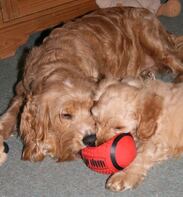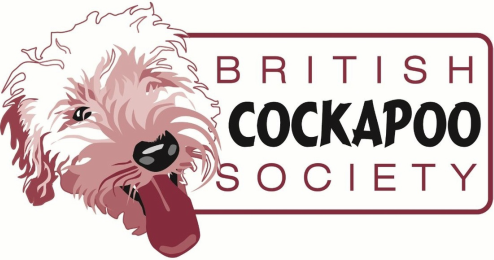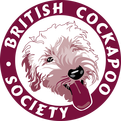INTRODUCING A SECOND DOG

Many people love having one dog and just can’t resist getting another dog or puppy to double the fun. It’s a great idea for us humans, but will the established dog of the household welcome the newcomer?
Let’s face it, the established dog has a great time as a singleton—all the love, all the attention, all the toys and all the space on the settee, so why would it want another set of paws to interfere with that!
Getting the senior dog to accept the incomer, is the first step and the better this is managed, the better chance there is of making their friendship long lasting.
When introducing a puppy, remember that they tend to have bags of energy, initially like to chew a lot, can be bouncy and a bit full on.
Not all older dogs like this attitude, and it can be the cause of friction, but that depends on the age and personality of the established dog.
Right from the beginning, your older dog needs to be shown that having a puppy is a good thing for it. To do this, be in a room with your dog, and ask a friend or relative bring the puppy into the room too.
Don’t let the dogs interact, but as soon as the pup is there, give the established dog a lot of praise, and treats.
Ask your friend to leave the room with the pup, and as soon as the pup goes, stop giving your dog rewards and attention.
Then get your friend to return with the pup, and start again giving praise and rewards. Your dog will learn that the presence of the pup means great things for it.
When your dog is relaxed about the pups presence, and is interested in it, then they can interact under supervision.
Even the most mild mannered dog can be a bit possessive over specific items when there is a second dog on the scene. Things like toys, bones, food etc take on an increased importance. Keeping the peace can be a case of management and prevention, so give toys when the dogs are on their own, feed separately if necessary and if your dog is showing signs of guarding of these things keep them out of the way.
Watch your older dog for signs that things are getting a bit much. Is it getting stressed, is the puppy looking for attention from it all the time, has your dog been able to get some ‘time out’ from the attention of the puppy? Managing their time together can be the number one factor in getting a peaceful duo, and making sure your older dog has some peace and quiet during the day can be a factor in keeping the peace.
When the pup is able to be taken out for a walk, it is a great opportunity for the pup to learn from the older dog. Training should start as soon as you get the pup, but will continue at these times too and this can also be a valuable refresher for your older dog.
Taking time to do some simple obedience training with both dogs, rewarding with tasty treats, can increase the bond between the two.
If you are introducing an older dog into the family, think about the established dogs personality. How is it with other dogs it meets? If your dog is a male is it neutered, does it like to dominate other males? If it shows signs of wanting to be ‘the boss’ then getting a quieter dog, maybe a bitch, might be something to consider.
Is the incoming dog a similar age to your established dog? How do their energy levels match up? Is your established
dog quiet, happy to snooze during the day and how does the new dog match up with that?
A new dog might give your established dog a new outlook on life but careful introductions and management may be needed.
Take the two dogs out to a neutral venue and go for a walk with both on their leads. When in a safe area, if they are happy with each other, let them both off lead to run and socialise. Always make sure that your established dog gets plenty of praise and attention, again doing little training sessions with rewards will help focus both dogs on you and give both attention.
Give your established dog extra rewards when he/she behaves properly around the new dog, and make sure toys, food etc do not become an issue by keeping them out of the way initially.
Other things you may have to consider when taking on a second dog are more practical. The cost of a second dogs insurance, especially if it is an older dog with known health issues can make a difference to outlay, as can the cost of extra food etc.
If you have a bitch and a dog, are they both neutered, if you have an entire dog and a female puppy how are you gong to manage the first season, when the two dogs will have to be kept apart. Do you have family one of the dogs can go to until it is safe for them to be together again?
You also have to consider the training and walking requirements for both dogs. Your established dog may be obedient and well trained (or not!) and your new one, puppy or older, might need a bit of work on obedience etc. This might mean that you have to spend time just with the new dog or puppy to teach it all you want it to know, walking one dog then spending time with the other. How will this impact on your day?
Initially both dogs will need to be supervised together and will need to be able to have their own space where they can get a bit of peace and quiet, but if managed properly having two dogs can be huge fun for both the humans and canines.
Let’s face it, the established dog has a great time as a singleton—all the love, all the attention, all the toys and all the space on the settee, so why would it want another set of paws to interfere with that!
Getting the senior dog to accept the incomer, is the first step and the better this is managed, the better chance there is of making their friendship long lasting.
When introducing a puppy, remember that they tend to have bags of energy, initially like to chew a lot, can be bouncy and a bit full on.
Not all older dogs like this attitude, and it can be the cause of friction, but that depends on the age and personality of the established dog.
Right from the beginning, your older dog needs to be shown that having a puppy is a good thing for it. To do this, be in a room with your dog, and ask a friend or relative bring the puppy into the room too.
Don’t let the dogs interact, but as soon as the pup is there, give the established dog a lot of praise, and treats.
Ask your friend to leave the room with the pup, and as soon as the pup goes, stop giving your dog rewards and attention.
Then get your friend to return with the pup, and start again giving praise and rewards. Your dog will learn that the presence of the pup means great things for it.
When your dog is relaxed about the pups presence, and is interested in it, then they can interact under supervision.
Even the most mild mannered dog can be a bit possessive over specific items when there is a second dog on the scene. Things like toys, bones, food etc take on an increased importance. Keeping the peace can be a case of management and prevention, so give toys when the dogs are on their own, feed separately if necessary and if your dog is showing signs of guarding of these things keep them out of the way.
Watch your older dog for signs that things are getting a bit much. Is it getting stressed, is the puppy looking for attention from it all the time, has your dog been able to get some ‘time out’ from the attention of the puppy? Managing their time together can be the number one factor in getting a peaceful duo, and making sure your older dog has some peace and quiet during the day can be a factor in keeping the peace.
When the pup is able to be taken out for a walk, it is a great opportunity for the pup to learn from the older dog. Training should start as soon as you get the pup, but will continue at these times too and this can also be a valuable refresher for your older dog.
Taking time to do some simple obedience training with both dogs, rewarding with tasty treats, can increase the bond between the two.
If you are introducing an older dog into the family, think about the established dogs personality. How is it with other dogs it meets? If your dog is a male is it neutered, does it like to dominate other males? If it shows signs of wanting to be ‘the boss’ then getting a quieter dog, maybe a bitch, might be something to consider.
Is the incoming dog a similar age to your established dog? How do their energy levels match up? Is your established
dog quiet, happy to snooze during the day and how does the new dog match up with that?
A new dog might give your established dog a new outlook on life but careful introductions and management may be needed.
Take the two dogs out to a neutral venue and go for a walk with both on their leads. When in a safe area, if they are happy with each other, let them both off lead to run and socialise. Always make sure that your established dog gets plenty of praise and attention, again doing little training sessions with rewards will help focus both dogs on you and give both attention.
Give your established dog extra rewards when he/she behaves properly around the new dog, and make sure toys, food etc do not become an issue by keeping them out of the way initially.
Other things you may have to consider when taking on a second dog are more practical. The cost of a second dogs insurance, especially if it is an older dog with known health issues can make a difference to outlay, as can the cost of extra food etc.
If you have a bitch and a dog, are they both neutered, if you have an entire dog and a female puppy how are you gong to manage the first season, when the two dogs will have to be kept apart. Do you have family one of the dogs can go to until it is safe for them to be together again?
You also have to consider the training and walking requirements for both dogs. Your established dog may be obedient and well trained (or not!) and your new one, puppy or older, might need a bit of work on obedience etc. This might mean that you have to spend time just with the new dog or puppy to teach it all you want it to know, walking one dog then spending time with the other. How will this impact on your day?
Initially both dogs will need to be supervised together and will need to be able to have their own space where they can get a bit of peace and quiet, but if managed properly having two dogs can be huge fun for both the humans and canines.
|
|
|

